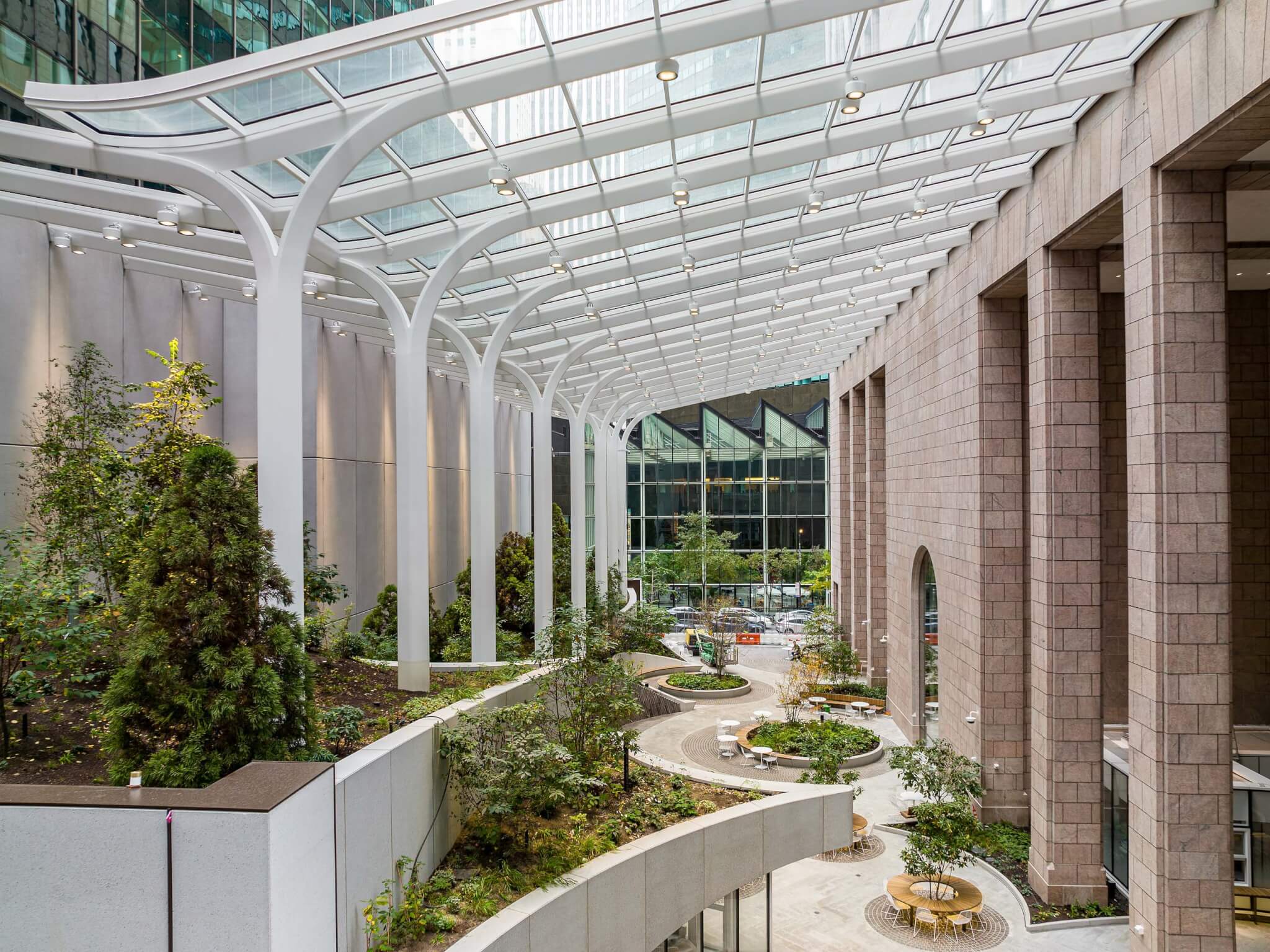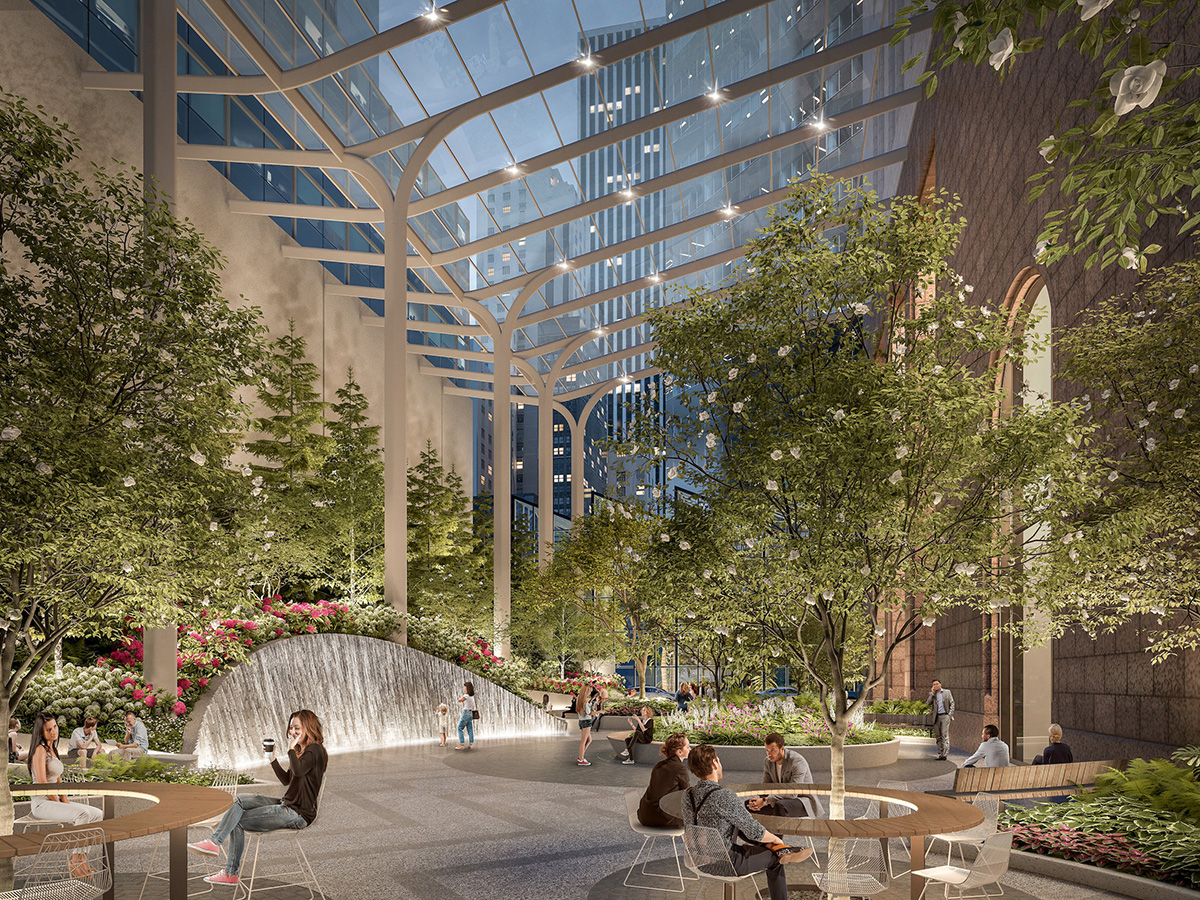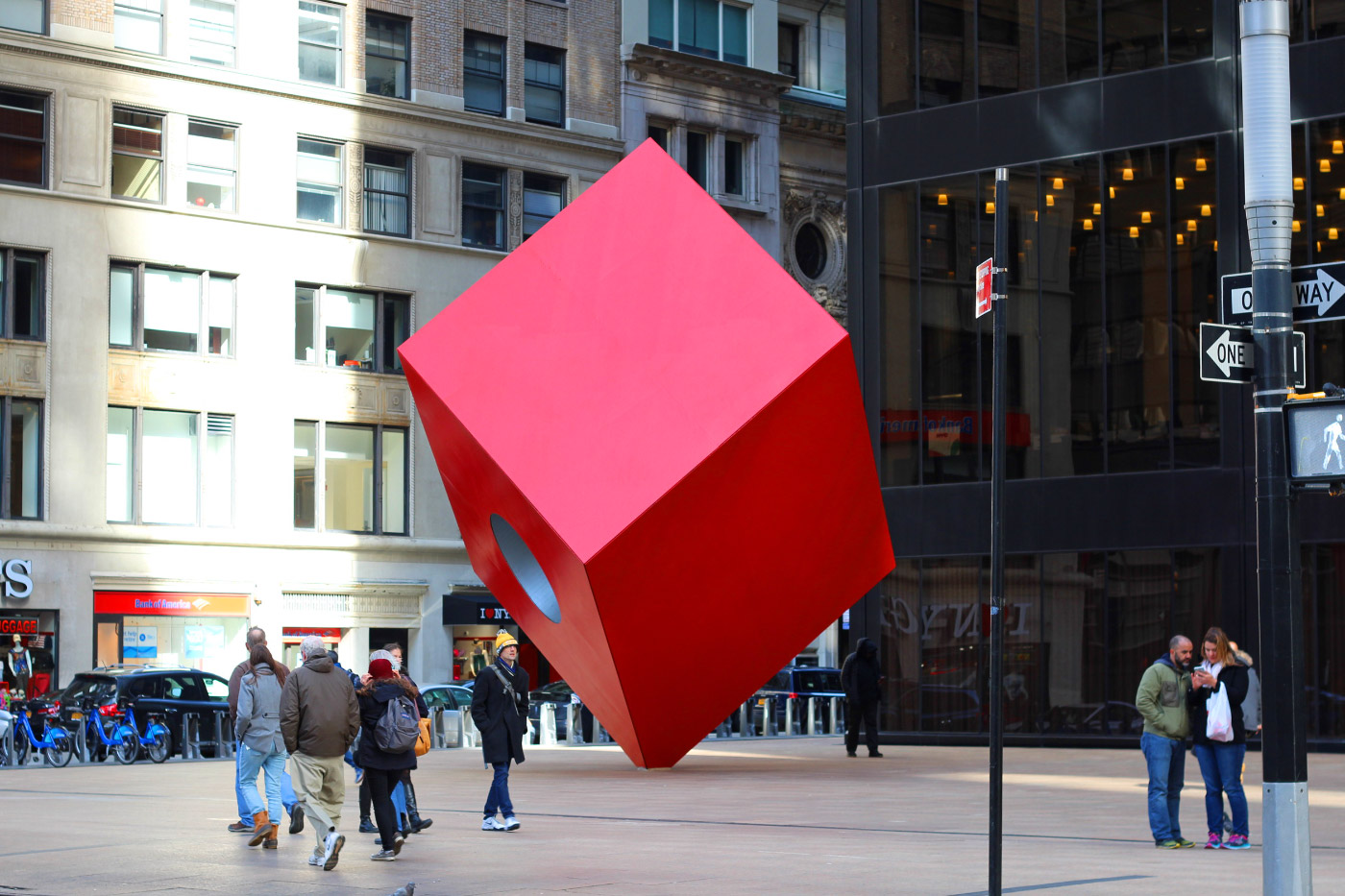In lower Manhattan, a prominent developer wants to convert a public space into private retail, and the city is at least a week away from a vote that could allow the project to move forward. Rockrose Development’s bid to completely enclose and privatize the arcade at 200 Water Street comes just months after the city permitted the destruction of the landmarked Sasaki fountain at the Citicorp Center, and is yet another example of a public outdoor space the city could cede to a commercial interest.
Rockrose wants to take advantage of new zoning rules that would allow the company to fill in the public arcade on Fulton Street with retail and restaurants, reducing the public space by half.
When they were built in the 1970s, the Water Street Arcades were a covered network of walkways linking office buildings in the area, which extends three blocks in from the East River, north to Fulton Street and south to Whitehall Street. The arcades and accompanying plazas were built as tradeoffs that let owners build taller than existing zoning allowed. The target area contains 20 buildings, with 225,000 square feet of open plazas and 110,000 square feet of arcades. In exchange for building and managing these privately-owned public spaces, or POPS, developers near Water Street got to add more than 2.5 million square feet of extra floor area to their buildings.
In June 2016, the City Council approved a zoning change that opened up these spaces to commercial development. The Water Street Upgrades Text Amendment allows existing arcades to be infilled for retail and encourages “improvement” of existing plazas. In total, the new rules place more than 167,000 square feet of the POPS up for redevelopment.
The city maintains that the arcades are dull and underutilized because they push ground-floor retail away from the sidewalk, are obstructed by thick structural columns and poorly lit, and often terminate in dead ends. It also asserts that the plazas mostly open onto lobbies and feature little greenery, a combination that is uninviting to passersby.
While some public spaces in the Water Street area do affirm these concerns, the ones at 200 Water Street are an exception. They originally featured exuberant public art, and are open to traffic on all four sides, a necessity for pedestrian circulation in an increasingly lively neighborhood.
From a design perspective, it would be hard to top the space’s first incarnation, which was cool enough to land on the cover of Progressive Architecture (PDF) one year after opening.
The original owner was the Kaufman Organization, a New York developer known for above-and-beyond stewardship of its POPS. Emery Roth & Sons designed 200 Water Street (also known as 127 John Street) in 1971 as an office building in the International Style, but CEO Melvyn Kaufman playfully messed with its gravitas, ornamenting the glass curtain wall from street to roof.
“One twenty seven John Street is neither imposing nor distinguished in the usual sense of those words,” said PA Associate Editor Sharon Lee Ryder. “It is imposing because you can’t forget it once you’ve been there and distinguished simply because there is nothing like it.”
Designer Pamela Waters used roofing gravel to craft a cheerful cat chasing a bird on opposite sides of the seventh floor setback, an almost wraparound terrace. Viewed from above, it’s clear that the terrace’s gap permanently prevents the cat from catching its prey (though there’s another wire mesh bird that covered the window-washing rig). On the roof, mechanical equipment was painted kindergarten colors and decked out in lights to illustrate water and air flowing through the HVAC system.
On the plaza level, metal benches in the same colors sat beneath Op Art murals that zigzagged through custom scaffolds all the way up to the edge of the sidewalk. Visitors could ascend the scaffolding to access seating on above the street. Around the corner at John and Water streets, Kaufman pasted mirrored walls onto two buildings that couldn’t move for the 32-story tower’s construction, while an inset digital clock on the Water Street side of the old building mimics the grid of the new tower. Melvyn Kaufman even installed a wax likeness of himself on one of the benches (it was removed after some unspecified “hostile reactions”). The arcade’s whimsy, capped off by a water feature and a neon-banded purple-and-blue light tunnel to the inside, was meant to enliven a long walk from the main entrance on Fulton Street to the building’s elevator bank.
Since the Kaufman Organization sold the building in the mid-1990s, the space’s cheerily excessive amenities have given way to a boring plaza that some believe is willfully neglected. Today, most of the remaining art from the Kaufman days is in serious disrepair: the white scaffolding is a blank skeleton, stripped of its canvas, while the original pool and fountain are empty. (The impossible-to-miss Water Street clock now graces a Starbucks, in front of a well-maintained but unoriginal public space occupied by wood benches and concrete planters.)
Rockrose maintains that the Fulton Street arcade is beyond rehabilitation, and proposes restaurants and retail as a way to enliven the front of the structure, which it converted to rental apartments in 1996. As soon as the end of this month, the City Planning Commission could hear Rockrose’s application to infill three of the building’s POPS, totaling more than 4,700 square feet, per rules outlined in last year’s zoning text amendment. The developer would like to add almost 1,800 square feet of new residential space in the double-height arcade facing Fulton, and on the ground floor, the plaza would lose about 3,000 square feet of public space. New York–based MdeAS is working with the developer to design the new spaces.
In return, Rockrose estimates it would receive $600,000 in annual rent from the new spaces. Members of Manhattan Community Board 1 (CB1), whose district includes the property, held meetings with Rockrose this summer to ask if the developer would consider compensating amenities. Rockrose refused, saying that, by law, it was not obligated to provide additional amenities.
CB 1 maintains that building into the arcade could interrupt the flow of connected spaces that distinguish the Water Street POPS and its buildings from the rest of the neighborhood. Though the city contends that the plazas are underused relics from bad midcentury planning, lower Manhattan is in the midst of a development boom that’s slated to bring more foot traffic at all hours to the traditionally 9-to-5 neighborhood. The intersection of Fulton and Water streets is a heavily-trafficked corner, the gateway to the South Street Seaport. Likewise, the South Street Seaport’s restaurant and tourist revival, including a new mall at Pier 17 and ferry service from nearby Pier 11, herald an increase in pedestrian traffic at Fulton and Water streets at what is already a busy intersection. According to CB1, Rockrose hasn’t submitted a pedestrian traffic study on the impact of enclosing almost 4,000 square feet of space at this corner.
At press time, multiple attempts to reach Rockrose for comment on its plans for 200 Water Street were unsuccessful.
Mindful of the precedent-setting nature of Rockrose’s request, and its dissatisfaction with the developer’s concessions, the community board voted the whole proposal down last month. The board released a statement, “CB 1 should urge the owners of the site and all stakeholders to maintain and keep the critically needed open space at 200 Water Street open for the public’s use consistent with the original agreement made between the developers and the citizens of New York.”
In a March 2016 resolution, just before the City Planning Commission passed the Water Street zoning rules, CB1 recognized the property as distinct from its neighbors, and asked the owners to not enlarge chain stores, but instead offer the community additional benefits:
“Owners of properties similar to 200 Water Street, where the benefit to the property owner clearly outweighs the community benefit from plaza upgrades, should be required to provide benefits in addition to the plaza upgrade, such as enhancements to surrounding sidewalks and the nearby Pearl Street Playground. CB1 requests that the arcade infill at 200 Water Street not be used just to expand the existing large box retail, and prefers retail that positively activates Fulton Street.”
(Despite this shout-out, CB1 nevertheless supported the Water Street Upgrades Text Amendment last year.)
Multiple nonprofit urban advocacy groups have weighed in on Rockrose’s proposal. In an open letter, the City Club of New York suggested Rockrose’s “lack of enthusiasm” for maintaining the POPS was an aegis for redevelopment-by-neglect. “In this case, converting half the space of the POPS to rental floor area and reducing the area maintained for the public by half is clearly a win-win for the owner,” it said.
Echoing the City Club’s statement, the Municipal Art Society praised the original character of the spaces, adding that “[the] plazas and arcade have been allowed to deteriorate to the point that, instead of preserving these valuable community assets, Rockrose stands to benefit from the loss of public space.”
This is not the first time Rockrose’s stewardship of public space has been in called into question. The original designers sued Rockrose back in 1996 over its alleged failure to maintain the plaza and its art, which Rockrose owns. The parties reached a court-approved settlement that required the firm to maintain the artwork in the POPS through 2011. In a brief, the plaintiffs’ attorney, Robert Ward, described the significance of the agreement: “When the building was built back in 1971, the owners got a plaza bonus. They were able to build a bigger building because of the plaza. The new owners of the building want to build in that plaza, but they do not want to take some of the building down. That is an important issue in terms of balancing the equities.”
There may be other options for reuse, though, that preserve the public space. In a letter to Marisa Lago, chair of the City Planning Commission, the group Friends of Privately Owned Public Spaces suggested three ways that Water Street Arcades could be creatively repurposed without reducing the total amount of public space. The owner could glass in an arcade to make a public interior and collaborate with a public entity like the New York Public Library for programming, or create a POPS with a food service component a la Lincoln Center’s David Rubinstein Atrium. As a last option, the owner could cede space to a city-run concession (like the ones operated by NYC Parks) whose proceeds would fund improvements to other POPS in the area.
At the earliest, the City Planning Commission could review the application on October 30, although no public testimony will be heard at that meeting. To comment on Rockrose’s proposal, members of the public may email the commission at centralintake@planning.nyc.gov with the subject line “Application N 170284 ZAM 200 Water Street Arcade Enclosure.” The commission’s website is updated regularly, so readers should check back there for the latest hearing schedule.
Editor’s Note: Last year, The Architect’s Newspaper sponsored a design charrette for the Water Street POPS to envision how they could become the vibrant gathering spots and successful corridors they once were. In May 2016, AN Managing Editor Olivia Martin also provided testimony opposing the Water Street Upgrades Text Amendment at a meeting of the Subcommittee on Zoning and Franchises. Martin had no role in reporting, fact-checking, or editing this story.










